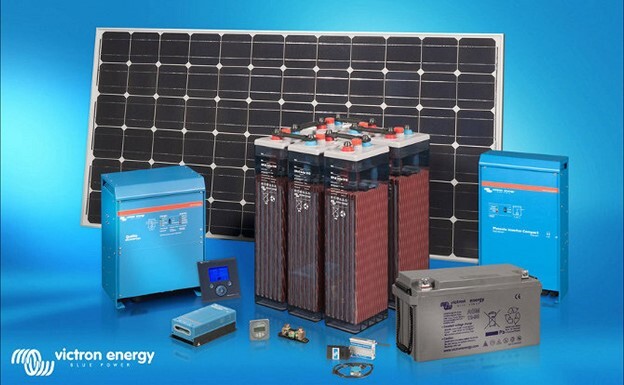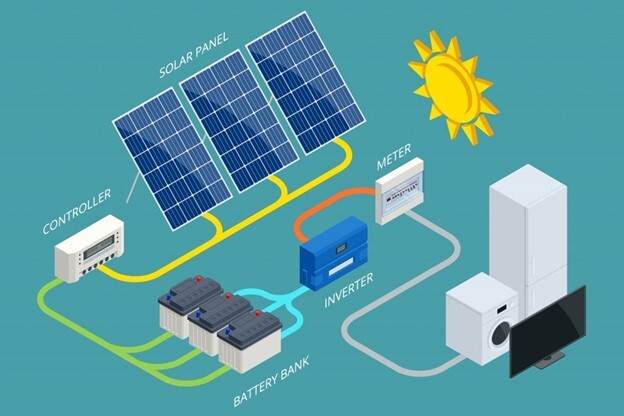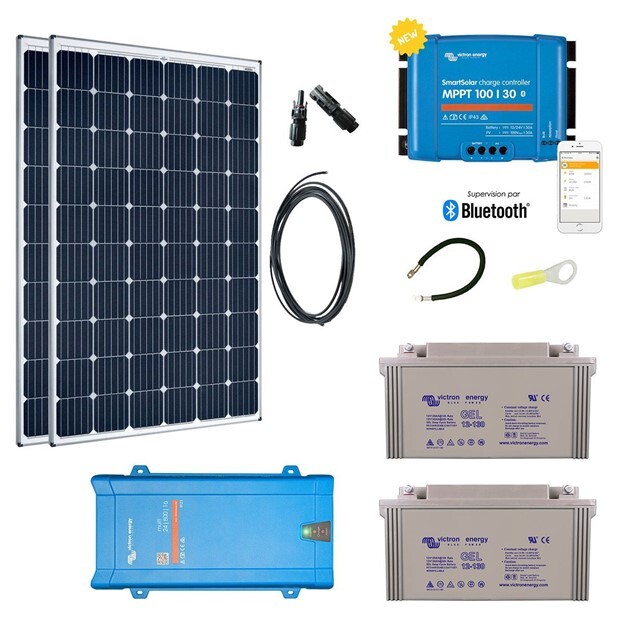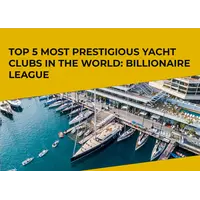In this review, topRik experts share their experience of using energy storage systems that are equipped on yachts with solar panels.
There are some nuances to generating electricity using sunlight. Solar generation systems today are not able to generate energy around the clock. They operate periodically as long as there is a sufficient level of illumination or intensity of sunlight to generate current.
On the other hand, as long as solar intensity is high, solar cells can generate even more electricity than is needed during periods of particularly efficient operation of solar panels. So that this energy does not go to waste, it needs to be accumulated somewhere, stored and released into the network in the dark or in the absence of sufficient intensity of solar radiation in cloudy weather.
This is what energy storage systems are for. On a yacht, such systems are rechargeable batteries. By storing excess energy, they provide a stable energy supply in the absence of sunlight.
By having reliable energy storage systems on board, you significantly increase the autonomy of your solar powered yacht. This means that you have the opportunity to develop longer passages, and there is no need to frequently call at ports and marinas.
And don’t forget: solar energy accumulated in its storage systems is absolutely free. Of course, you will have to spend money on purchasing marine batteries for solar panels. But if you know the characteristics of each type, as well as their lifespan, it turns out that this is not such an expensive acquisition. topRik experts talk about the features of using energy storage systems on boats with solar panels in this article and at the end they give a brief overview of some popular systems. In the relevant sections of the topRik marketplace you will find marine batteries for solar panels of various types from the world's best manufacturers of electrical equipment for yachts – Victron Energy, Ultimatron France, OPTIMA, Energizer, Varta, etc.

Types of Batteries for Yachts
The most common types of batteries used in solar panels are lead-acid and lithium - they are divided according to the type of chemistry. Each has its own advantages and disadvantages regarding capacity, cost, life cycle, safety and operating temperature range.
Below is a table of the advantages and disadvantages of these two types of energy storage systems, including their variations. Maintained and maintenance-free rechargeable batteries are identified, as well as options based on the type of electrolyte: liquid, absorbed in glass fiber (AGM) or gel (GEL). In the group of lithium-ion batteries, the table separately identifies batteries based on lithium iron phosphate (LiFePO4) and lithium-ion titanate (LTO).
|
Battery type |
Advantages |
Flaws |
|
Lead-acid maintenance-free, AGM |
Sealed design Ease and safety of use Affordable price Slight self-discharge Excellent performance in buffer mode |
Low energy density Non-linear discharge curve Low charging currents – 0.1-0.2C Sensitivity to high charge voltages Resource – up to 350 cycles Inability to support constant load |
|
Lead-acid maintenance-free, GEL |
Sealed design Can be used in an inclined position and on its side Ease and safety of use Slight self-discharge |
Low energy density Non-linear discharge curve Low charging currents – 0.1–0.2C Resource – up to 500 cycles |
|
Lead-acid serviceable, with liquid electrolyte, type OPzS (armoured) |
Resource – up to 1500 cycles, thanks to the use of a tubular anode High reliability |
Low energy density Nonlinear discharge graph Risk of liquid electrolyte leakage High cost Small charge currents – up to 0.3C |
|
Lead-acid sealed type OPzV (shell-clad, with electrolyte in gel form) |
Sealed, maintenance-free design Resource – up to 1500 cycles High reliability |
Low energy density Non-linear discharge curve Small charge currents – up to 0.3C High cost - comparable to the cost of lithium iron phosphate batteries |
|
Li-ion |
Low weight High energy density Compact Simplicity and comfort of use Resource more than 1000 cycles Excellent performance parameters Low self-discharge |
If the seal is broken and the normal operating mode is left behind, there is a risk of fire - to eliminate such situations, BMS protection and control boards are required |
|
LiFePO4 |
Comfort, ease and safety of use Resistance to fires and explosions Resource – more than 3000 cycles Resistance to high currents and deep discharges Linear discharge characteristics Possibility of using smaller capacity batteries at higher discharge currents Ability to accept high charge currents – up to 2C Minor self-discharge Wide operating temperature range |
High initial investment, but in terms of the cost of 1 cycle - an excellent choice |
|
LTO |
In addition to all the advantages of LFP batteries - huge charge currents (up to 10C), resource life 16,000 and above |
High cost, but in terms of the cost of 1 cycle - the opposite Heavy weight (low specific energy intensity) |
While you can choose from the types of batteries listed in the table for your power supply system on a yacht with solar panels, we don’t even recommend looking at alkaline batteries for this purpose. Ni-Cd and NiMH batteries cannot accept a charge with low currents produced by solar panels, therefore they are absolutely not suitable for use in solar power systems. They can be used for autonomous energy systems based on diesel generators.
Comparison of Lead-Acid and Lithium-Ion Batteries
The production technology of various types of energy storage systems affects their characteristics and determines their advantages and disadvantages. To find out which type of battery best suits specific requirements, you need to compare their differences. A comparison of the main parameters is given in the table.
|
Comparison criterion |
Lead-acid |
Li-ion |
|
Resource |
About 500 cycles |
About 1000 cycles or more, depending on the type of chemistry |
|
Weight |
Heavy |
Lungs |
|
Specific energy intensity |
Low |
High |
|
Price |
Below |
Higher |
|
Maintenance |
Adding distilled water (for serviced models), periodically cleaning from oxide, replacing jumpers, blowing off dust and dirt |
You just need to keep an eye on battery condition and charge it |
|
Charging time |
8–12 hours |
2 hours |
|
Possibility of multi-shift use, for example, for cleaning or warehouse equipment |
No |
Yes |
|
Possibility of fractional charging and fast recharging |
No |
Yes |
|
Memory effect |
Eat |
Not observed |
|
Harmful emissions |
Possible gas release and electrolyte leakage (for serviced models) |
No |
|
Need for dedicated charging space |
Yes |
No |
|
Charge efficiency |
Up to 65% |
Up to 85% |
Key Characteristics of Energy Storage Systems
The batteries presented on the marketplace differ not only in their manufacturer, but also in their technical and operational characteristics. When choosing the appropriate option, be sure to take into account the following parameters:
- The amount of energy a battery can store. It is measured in ampere hours (Ah) or kilowatt hours (kWh). The larger the capacity, the more energy the battery can store, allowing for longer periods without solar power (running on backup energy).
- Rated voltage. This is the voltage at which the battery can operate successfully. Typically, solar panels use storage devices with voltage ratings of 12, 24, or 48 volts.
- Life cycle. Determines how many times the battery can be fully charged and discharged before its performance degrades. A high cycle means the drive can last longer.
- Self-discharge. Reflects the battery's ability to hold its charge while the device is not in use. The lower the self-discharge, the longer the battery retains its energy without recharging.
- Charging and discharging speed. Some storage devices have higher speeds, allowing you to use solar energy more efficiently and meet peak energy demands.
- Cycle resistance. This is the number of full charges and discharges that the battery can withstand over its entire service life while maintaining its original capacity without loss of performance.
- The housing design can be sealed or maintenance-free, which requires monitoring the electrolyte level and adding distilled water during evaporation. Maintenance-free devices are more convenient and safe to use, because... When using them, the risk of exposure to chemical components on the human body is minimized.
Important requirements for energy storage devices are long service life, low self-discharge and a wide range of operating temperatures. The technical characteristics of the battery (capacity, charging/discharging currents, weight, dimensions, operating conditions) must be selected taking into account the operating characteristics of a particular power plant. Let's look at some of these characteristics in more detail.
Capacity
In most cases, you can use multiple storage devices in a solar system to increase capacity. Capacity of the battery, but does not indicate how much electricity the drive can provide at a given moment. To do this, you need to take into account the rated power - this is the amount of electricity that the battery can transmit at one time. Measured in kilowatts (kW).
A high capacity, low power battery will provide a low amount of electricity (enough to run a few important appliances) for a long time. A low-capacity, high-power storage device can supply the entire boat with electricity, but only for a few hours.
Cyclicity and Durability
In the solar system of a yacht, the storage device operates in a cyclic mode every day (charged and discharged). Its ability to hold a charge will gradually decrease as you use it.
An analogy can be made with the battery in your smartphone: you charge the gadget every night to use it during the day, and over time you notice that it does not hold a charge as well as before.
Each battery comes with a warranty that specifies the number of charge-discharge cycles and/or years of useful life. Since battery performance naturally degrades over time, most manufacturers also guarantee that the device will maintain a certain capacity for the duration of the warranty.
Example: a battery may have a 5,000 cycle or 10-year warranty stating that after that it will retain less than 70% of its capacity. This means that after the warranty expires, the battery will lose no more than 30% of its original energy storage capacity.
Weight and Dimensions
If for a solar power plant of a building the weight and dimensions of energy storage devices are not of particular importance, then for a yacht, where every free centimeter is valued and every extra kilogram is fought against, these are very important parameters.
For example, Li-ion models of the same capacity are approximately 2 times lighter and more compact than lead-acid batteries, but also much more expensive.
Self-Discharge Level
This is a characteristic of loss of charge when there is no load on the battery, at idle. Reflects the efficiency of the battery during long-term storage of accumulated energy.
Due to the nature of the device, most batteries must maintain a minimum charge level. If you regularly use 100% battery power, its life will be significantly reduced.
Depth of discharge (DoD) is the percentage of the storage capacity that has been used after a full charge. Most manufacturers indicate the maximum DoD value that is acceptable for the battery. Depends on the storage temperature of the batteries. For example, the self-discharge of lead-acid batteries when stored for a year at a temperature of +20 °C is 40%, and at +5 °C - 15% of the capacity.
Thus, for a 10 kWh battery with a 90% depth of discharge, it is acceptable to use no more than 9 kWh before recharging. The higher the DoD level, the more of the battery capacity is available for use.
For long trips on a yacht, storage systems with a low self-discharge level are preferable.
Integration with Solar Panels
As we have already found out above, the solar panel module does not supply electricity directly to consumers, but charges the storage batteries of the circuit. They accumulate electricity and then transmit it to end consumers, which include navigation equipment, yacht lighting, refrigerators, electric stoves, etc.
But all these solar panels with an energy storage system represent a small mini-solar station, in which it is not enough to simply connect solar panels with storage batteries. Their integration with solar panels is done using a controller and an inverter. The controller regulates the charging process and the inverter converts battery electricity in accordance with the parameters of the consuming equipment.

Charge Controllers
Solar charge controllers play a key role in optimizing and protecting the solar energy system. We list only the most basic functions that should convince you that this device is extremely necessary in the solar system of a yacht.
- Charge regulation. The most basic function of solar controllers is to regulate the electrical current flowing from the solar panels to the batteries. Without a controller, solar panels can transfer more energy than the battery can accept, causing it to overcharge. Overcharging can seriously damage the battery and shorten its life.
- Prevent reverse discharge. At night, when solar panels are not producing energy, electricity can begin to flow in the opposite direction, from the battery back to the panels, causing the battery to drain. Solar controllers prevent this reverse flow of energy.
- Performance optimization. This is especially true for MPPT controllers, which can regulate the input voltage from solar panels to maximize battery charge in all weather conditions. They allow the system to operate at peak efficiency, which is especially useful in areas with variable weather or during different seasons.
- Overload or short circuit protection. The internal safety mechanisms of solar controllers help prevent potentially dangerous situations such as overload or short circuit. This provides additional security for your solar energy system.
- Energy conservation. In some systems, solar controllers also manage the energy output for loads, preventing unnecessary energy use and extending battery life.
There are two main types of charge controllers: PWM - Pulse Width Modulation and MPPT - Maximum Power Point Tracking.
PWM controller technology is an earlier and simpler solution for battery charge management in solar systems. They regulate the charging current, allowing a full charge of current to flow when the battery level is below a set threshold and stopping it as the battery approaches full charge.
During the charging process, they switch to a "maintenance" or "trickle charge" state when the battery reaches a certain charge level, providing a small amount of current to maintain that level.
PWMs are a cheaper solution and are suitable for systems with small voltage differences between solar panels and batteries. They are suitable for small systems where high efficiency is not required, such as on a small boat.
PWMs, in turn, come in two types: shunt and series.
Shunt controllers work by creating a "bypass" or "shunt" path for electrical current when the battery reaches its maximum capacity. This prevents the battery from overcharging by redirecting excess energy. Shunt controllers are usually easy to use and inexpensive, but they can be inefficient because they do not use excess energy.
Series controllers, unlike shunt controllers, interrupt the flow of energy from the solar panels to the battery when it is fully charged. They do this by “disabling” the solar panel. Series controllers are generally more efficient than shunt controllers because they prevent energy loss through the shunt. However, they can be more difficult to install and maintain.
MPPT controllers are a more modern and efficient solution. They are able to adapt to changing lighting and temperature conditions and vary the input voltage from solar panels to maximize its conversion into electricity.
Unlike PWM controllers, MPPT controllers constantly monitor the solar panels' maximum power point and adapt the charging current accordingly. This allows you to significantly increase the efficiency of the solar system, especially in sailing regions with variable weather conditions and is very important during long-distance voyages.
However, MPPT controllers are typically more expensive and more complex to install and maintain, making them more suitable for solar systems on larger yachts.
Setting up and optimizing the operation of the controller must be carried out in strict accordance with the instructions from the manufacturer. Usually this process is described step by step by serious manufacturers, but it is better if a specialist with the appropriate tolerances does this.
Setting up controller parameters includes operating modes, charging and discharging voltage, timers and other options. Settings should be matched to your boat's solar system requirements and energy consumption levels.
Correctly setting up the solar controller allows you to efficiently use solar energy and maximize battery life.
Energy Monitoring and Management Systems
Automation of charge and discharge control is a function of your yacht's solar system controller. But the level of this automation depends precisely on the type of controller that we described above. How does each of these varieties manage incoming energy?
The task of PWM controllers is to control the power unit to regulate the voltage at its input within a given range using feedback signals.
In this case, PWM controllers can additionally:
- take into account the temperature of the electrolyte using a built-in or remote sensor (the latter method is more accurate),
- create temperature compensation for charging voltages,
- configured for a specific type of battery (GEL, AGM, liquid acid) with different voltage graphs at the same points.
MPPT controllers also work using the pulse-width converter method, but they are extremely accurate because they take into account the largest amount of power that solar panels are capable of delivering. This value is always precisely defined and entered into the documentation.
For example, for 12 V solar batteries the maximum power release point is about 17.5 V. An ordinary PWM controller will stop charging the battery when the voltage reaches 14-14.5 V , and one operating using MPPT technology will allow additional use of the resource of solar panels up to 17.5 V.
As the depth of battery discharge increases, energy losses from the source increase. MPPT controllers reduce them.
In this way, MPPT controllers, using pulse-width conversions in all battery charging cycles, increase the output of the solar battery. Depending on various factors, savings can be 10-30%. In this case, the output current from the battery will exceed the input current from the solar battery.
Modern technologies already offer systems for monitoring and managing energy on a yacht, which can be used remotely. The topRik marketplace has a fairly wide range of such monitoring systems, including devices and applications for monitoring the condition of batteries.
Victron's simplest battery monitor yet Energy, a digital monitoring panel from the same manufacturer, or an entire system with additional functions and a switchboard from Simarine, which allows you not only to monitor the condition of the batteries, but, if necessary, to disconnect and even switch them from a distance.
Review of Popular Energy Storage Systems
We immediately warn you that in this section we are not so much presenting energy storage systems that can be purchased on the topRik marketplace, but rather introducing you to those manufacturers of solar batteries that are not yet widely represented on our marketplace. After all, you can already get acquainted with the systems that the marketplace offers in the corresponding section. We made the only exception for Victron Energy, and we will explain why below.
Victron Energy
What attracted us to the features and benefits of Victron Energy storage systems is the opportunity to create a perfectly compatible solar station on a yacht of any size and configuration.
Any experienced marine electrician will confirm that one of the reasons for the failure of a yacht's electrical system or its components is often the incompatibility of equipment, connectors and cables.
Victron Energy reduces this problem to zero. The company (in addition to other electrical and energy equipment and accessories for yachts and land objects) produces all components for installing a solar system on a yacht:
- solar panels of all types;
- rechargeable batteries of all types for energy storage;
- MPPT solar controllers;
- solar inverters;
- cables and connectors;
- monitoring systems;
- programs and applications for remote control of a yacht's solar system.

Experience of topRik's experts at sea confirms that this famous company from the Netherlands knows a lot about autonomous systems. It does not let our sailors down either on long voyages or on cruise routes.
Battle Born Batteries
Battle Born Batteries company began in 2013 by bringing efficient, stable and powerful lithium-ion batteries to market, powering boats, caravans and people living off-grid around the world.
Battle Born provides sustainable, safe and high-performance energy storage solutions for boats, caravans and off-grid living, including a full line of LiFePO4 batteries, power kits and accessories.
The company's lithium iron phosphate batteries are known for their reliability, chemical stability and advanced technology.
Relion
The manufacturer is distinguished by highly efficient lithium-ion solutions. Relion is a renowned lithium battery brand from the USA with over 20 years of experience in the battery industry. The company offers a wide range of lithium batteries with voltages of 12 V, 24 V, 48 V and more to power solar panels on yachts, boats, RVs, golf carts, etc.
The Relion 12V deep cycle marine battery uses LiFePo4 battery technology which is durable, high performance, and most importantly maintenance free and can be used for virtually any type of boat.
Trojan Battery
American company Trojan Battery has been a leading manufacturer of high-performance rechargeable batteries for 80 years.
The company began its activities with the production of car batteries. In 1952, Trojan pioneered the development of a deep cycle battery for a golf cart. Trojan batteries currently power more than 98% of all machines used at leading golf courses in the United States.
In the 1960s, the company expanded its line of deep cycle batteries and moved to Santa Fe Spring in Southern California. The company's steady growth continued in the 1970s when it developed a series of batteries for cleaning machines.
But we are more interested in their developments for boats and these are lead-acid and other batteries for yachts, including for backup storage of electricity. Trojan offers a wide range of deep cycle, AGM and GEL batteries for renewable energy sources, hybrid systems and backup power supplies.
RE series wet batteries are designed specifically for heavy-duty applications in renewable energy systems such as solar (photovoltaic) systems, small wind turbines and mini-hydroelectric power plants. Trojan RE batteries are manufactured using T2 Technology, which ensures high performance, increased reliability and a long service life of up to 8 years. The number of cycles at a discharge depth of 80% is at least 1000.
Blue Sea Systems
Integrated energy storage and management systems from Blue Sea Systems are distributed far beyond Finland, the homeland of this brand. The initial goal of founding the company in 1992 was the desire to create innovative, high-quality and reliable electrical products to improve safety and comfort on board. Since then, the number of product names has increased significantly and has now exceeded a thousand. The company supplies its products to 50 countries for commercial, pleasure and special vessels.
Blue Sea Systems is a designer and manufacturer of electrical installation products, current interrupters, battery switches, switchboards for the marine sector: from small boats to the navy. The company has a wide range of products that have passed all global certification.
Blue Sea switches play a key role in electrical systems on yachts and boats. They provide the ability to manage and monitor the energy consumption of various devices and systems on board a boat. These switches provide safe power off and on and also allow you to switch between different power sources such as generators, on-board batteries, solar panels and external sources. In addition, Blue Sea’s mass systems play an important role in ensuring the reliable operation of the electrical system by preventing corrosion, as well as providing an effective grounding system to protect against overvoltages and short circuits.
And all Blue Sea products is designed and manufactured to high standards exclusively for marine environments, including salt water. It has special anti-corrosion properties, is made of materials that help protect systems and equipment from the effects of salt and moisture. Therefore, the use of Blue Sea products in a marine environment does not pose any corrosion concerns and ensures reliable operation of the yacht's electrical systems.








